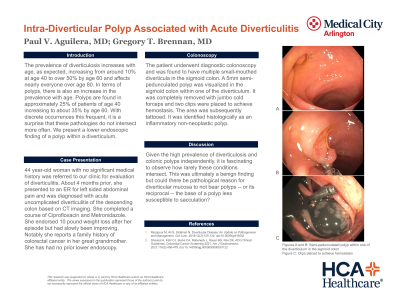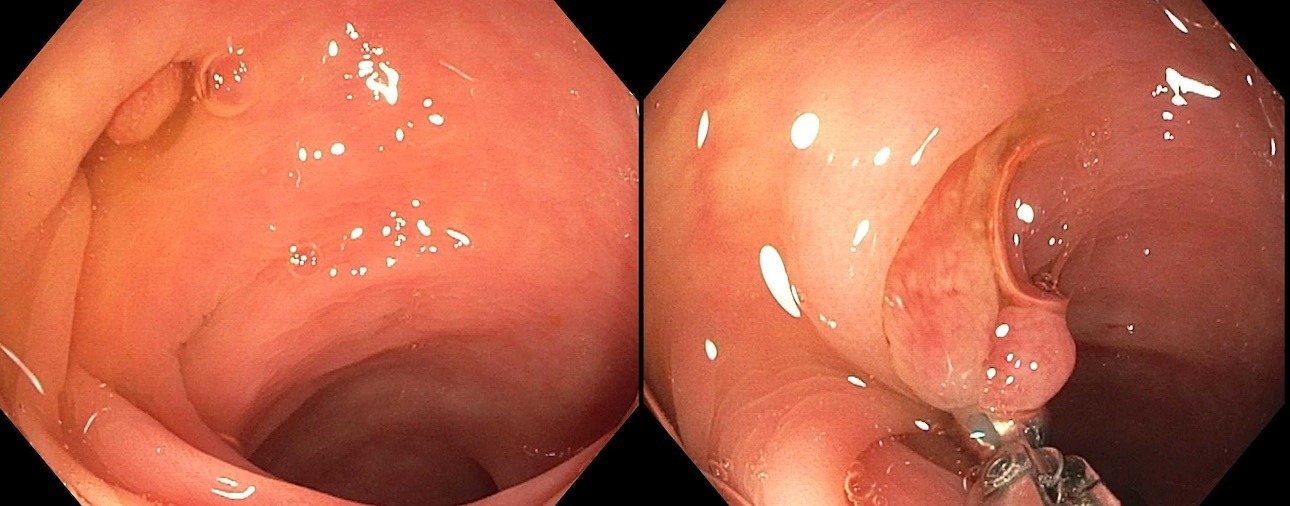Back


Poster Session D - Tuesday Morning
Category: Colon
D0148 - Intra-Diverticular Polyp Associated With Acute Diverticulitis
Tuesday, October 25, 2022
10:00 AM – 12:00 PM ET
Location: Crown Ballroom

Has Audio

Paul V. Aguilera, MD
Medical City Arlington
Arlington, TX
Presenting Author(s)
Paul Aguilera, MD1, Akshaj Pole, DO1, Gregory Brennan, MD2
1Medical City Arlington, Arlington, TX; 2GI Alliance, UNT Health Science Center, Mansfield, TX
Introduction: The incidence of both colon polyps and diverticulosis increases with age. Intra-diverticular polyps are a very rare findings despite the relatively high prevalence of both colon polyps and diverticulosis. Acute diverticulitis happens in approximately 5-10% of patients with diverticulosis. Risk factors for acute diverticulitis have been well described including age, NSAIDs, and dietary factors. There is limited evidence on the incidence of diverticulitis associated with colon polyps.
Case Description/Methods: A 44 year old woman with no significant medical history was referred for evaluation after a recent episode of acute uncomplicated diverticulitis confirmed on CT. She was treated with a short course of antibiotics in the outpatient setting. The patient had a normal BMI and was not using any NSAIDs previously. The patient subsequently underwent a diagnostic colonoscopy and was found to have sigmoid diverticulosis. A single 5 mm semi-pedunculated polyp was found arising from the base of a diverticulum (FIGURE 1). The polyp was resected using forceps to evert the diverticulum and fully visualize the polyp. Histologic examination revealed an inflammatory polyp.
Discussion: Here we present a case of a patient who was found to have an intra-diverticular polyp after an episode of acute diverticulitis. The patient had no other risk factors for acute diverticulitis which suggests the polyp may have been the underlying cause of the diverticulitis. Intra-diverticular polyps are rare. To the best of our knowledge, diverticulitis caused by such polyps is exceedingly rare. Polyp location or growth in the diverticulum may led to obstruction, inflammation or erosion of the thin diverticular wall. Because the polyp was inflammatory, we cannot rule out the possibility that it may have developed after the episode. Whether the polyp was the trigger or the result of diverticulitis, this rare association highlights the importance of a colonoscopy after an episode of acute diverticulitis to rule out other pathology.

Disclosures:
Paul Aguilera, MD1, Akshaj Pole, DO1, Gregory Brennan, MD2. D0148 - Intra-Diverticular Polyp Associated With Acute Diverticulitis, ACG 2022 Annual Scientific Meeting Abstracts. Charlotte, NC: American College of Gastroenterology.
1Medical City Arlington, Arlington, TX; 2GI Alliance, UNT Health Science Center, Mansfield, TX
Introduction: The incidence of both colon polyps and diverticulosis increases with age. Intra-diverticular polyps are a very rare findings despite the relatively high prevalence of both colon polyps and diverticulosis. Acute diverticulitis happens in approximately 5-10% of patients with diverticulosis. Risk factors for acute diverticulitis have been well described including age, NSAIDs, and dietary factors. There is limited evidence on the incidence of diverticulitis associated with colon polyps.
Case Description/Methods: A 44 year old woman with no significant medical history was referred for evaluation after a recent episode of acute uncomplicated diverticulitis confirmed on CT. She was treated with a short course of antibiotics in the outpatient setting. The patient had a normal BMI and was not using any NSAIDs previously. The patient subsequently underwent a diagnostic colonoscopy and was found to have sigmoid diverticulosis. A single 5 mm semi-pedunculated polyp was found arising from the base of a diverticulum (FIGURE 1). The polyp was resected using forceps to evert the diverticulum and fully visualize the polyp. Histologic examination revealed an inflammatory polyp.
Discussion: Here we present a case of a patient who was found to have an intra-diverticular polyp after an episode of acute diverticulitis. The patient had no other risk factors for acute diverticulitis which suggests the polyp may have been the underlying cause of the diverticulitis. Intra-diverticular polyps are rare. To the best of our knowledge, diverticulitis caused by such polyps is exceedingly rare. Polyp location or growth in the diverticulum may led to obstruction, inflammation or erosion of the thin diverticular wall. Because the polyp was inflammatory, we cannot rule out the possibility that it may have developed after the episode. Whether the polyp was the trigger or the result of diverticulitis, this rare association highlights the importance of a colonoscopy after an episode of acute diverticulitis to rule out other pathology.

Figure: FIGURE 1. Left: Intra-diverticular polyp. Right: Forceps were used to fully visualize and resect the polyp.
Disclosures:
Paul Aguilera indicated no relevant financial relationships.
Akshaj Pole indicated no relevant financial relationships.
Gregory Brennan indicated no relevant financial relationships.
Paul Aguilera, MD1, Akshaj Pole, DO1, Gregory Brennan, MD2. D0148 - Intra-Diverticular Polyp Associated With Acute Diverticulitis, ACG 2022 Annual Scientific Meeting Abstracts. Charlotte, NC: American College of Gastroenterology.
